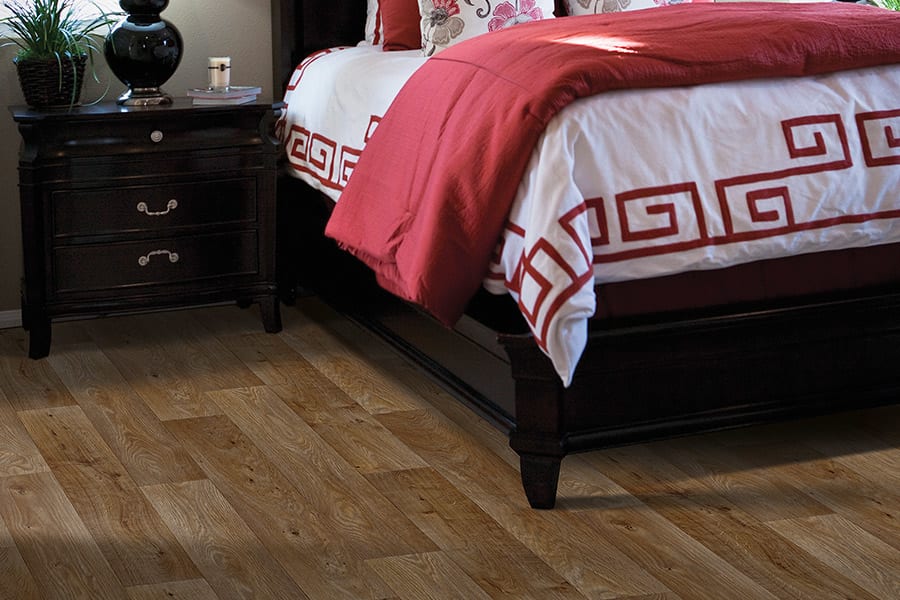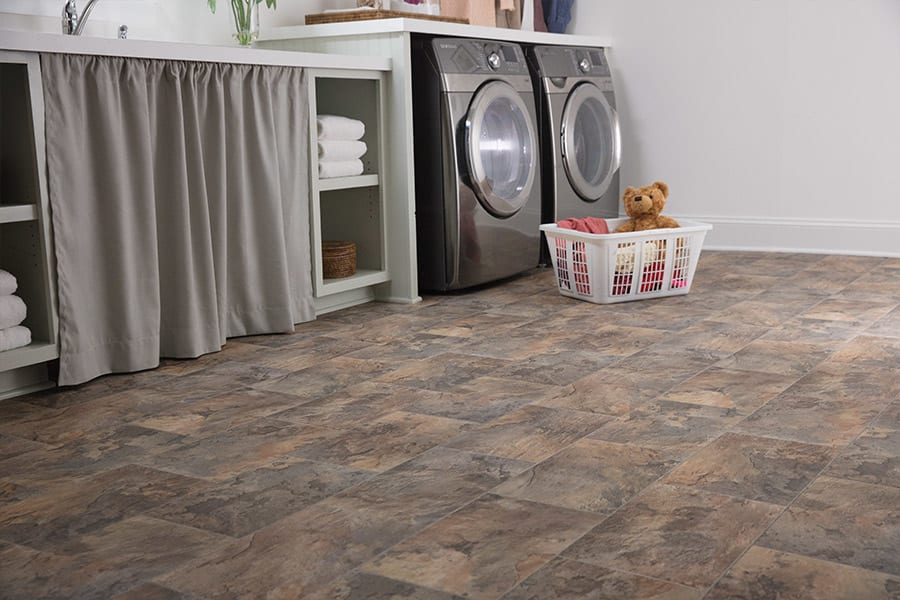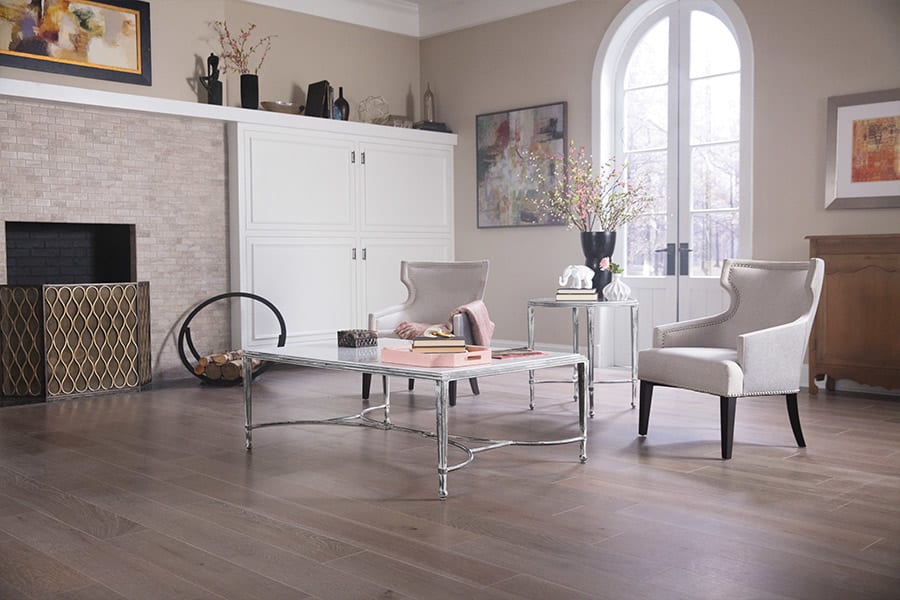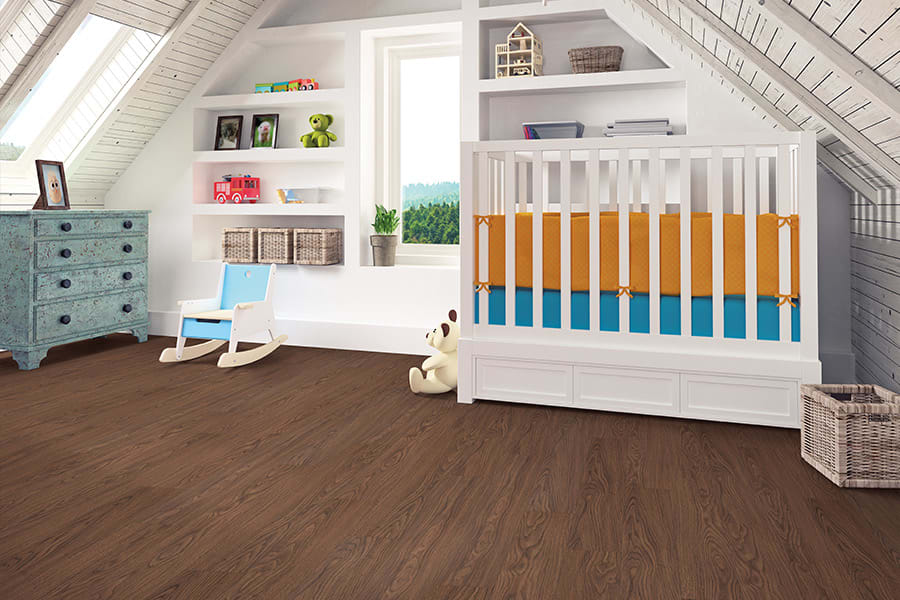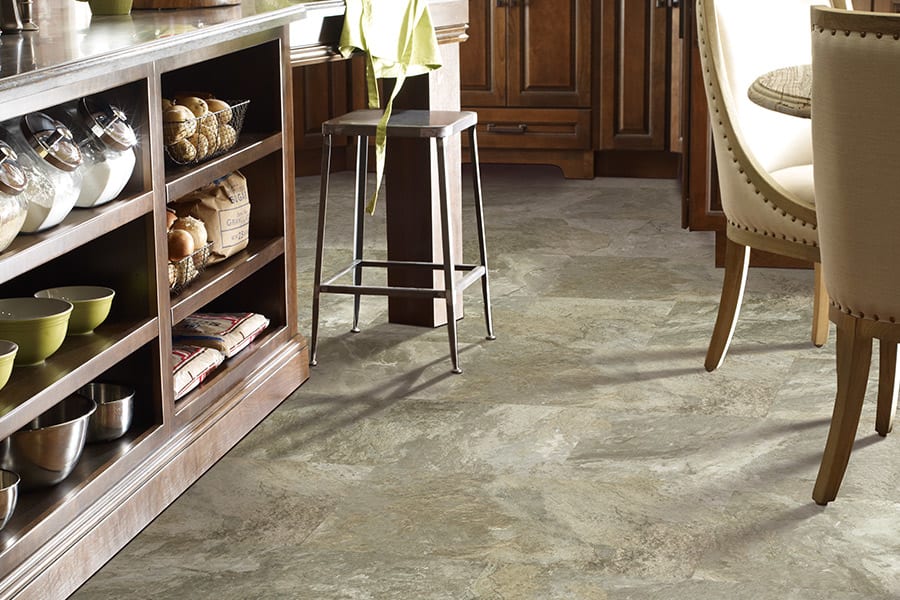Marietta, GA Design Center
Filled with ideas & inspiration
 770-565-3808
770-565-3808
 Showroom hours:
Showroom hours:
Mon-Sat 10:00 am - 05:00 pm
Sun Closed
Filled with ideas & inspiration
Mon-Sat 10:00 am - 05:00 pm
Sun Closed
Request a free flooring estimate
FREQUENTLY ASKED QUESTIONS ABOUT LUXURY VINYL
1. What is the difference between vinyl and luxury vinyl?
Vinyl (also called resilient flooring) is a solid piece (sheet) of flooring that is on a roll 12 (and sometimes 13’2” or 6) feet wide. Luxury vinyl is smaller individual pieces of vinyl material. Both vinyl and luxury vinyl are considered waterproof. Care and maintenance are identical for both products, what differs is the installation method.
2. What exactly is luxury vinyl?
Luxury vinyl is available in wood looks (3” to 9” wide planks) and tile and stone visuals. The tiles can sometimes be grouted if desired, and are available in a variety of sizes, including popular 16” x 16” and 12” x 24” sizes. The digital technology being utilized creates extremely realistic patterns and textures. Luxury vinyl is an extremely moisture resistant floor. Luxury vinyl is very durable, stain resistant, and most are rated for commercial use. Most even have attached backings, which add warmth, cushioning, and sound deadening properties. Luxury vinyl can be scratched or damaged, for instance, by dragging a large appliance over it, but most styles offer the flexibility to remove the damaged piece and replace it. We recommend keeping a partial box on hand, just in case.
The term “luxury” can be a little misleading. While it can be more expensive than traditional sheet vinyl, LVT/LVP is not only affordable, but it can also be an incredibly far-sighted smart purchase. The higher end floors realistically mimic natural materials better than ever before. LVT is more comfortable than tile. It is true, you could just get a real stone or wood-look tile and it would also be waterproof. But tile is hard. Standing on a tile floor all day is not great for your joints or feet. Vinyl is more resilient, much more comfortable, and also quite easy to take care of. All you need is the occasional vacuum and damp mop to keep your floor looking fabulous.
You can see pictures of our installations on our Facebook (Enhance Floors and More) and Instagram (enhancefloors) pages.
The term “luxury” can be a little misleading. While it can be more expensive than traditional sheet vinyl, LVT/LVP is not only affordable, but it can also be an incredibly far-sighted smart purchase. The higher end floors realistically mimic natural materials better than ever before. LVT is more comfortable than tile. It is true, you could just get a real stone or wood-look tile and it would also be waterproof. But tile is hard. Standing on a tile floor all day is not great for your joints or feet. Vinyl is more resilient, much more comfortable, and also quite easy to take care of. All you need is the occasional vacuum and damp mop to keep your floor looking fabulous.
You can see pictures of our installations on our Facebook (Enhance Floors and More) and Instagram (enhancefloors) pages.
3. Where can I install luxury vinyl?
Luxury vinyl is perfect for
locations where water is prevalent—bathrooms, laundry rooms, mud
rooms, and kitchens. It is also great in basements and playrooms,
where you need a floor that is practical and hardworking as well as
comfortable.
4. How is luxury vinyl installed?
There are primarily two
installation techniques for luxury vinyl: fully adhered (glued) to
the subfloor and click (floating).
5. Is luxury vinyl new?
No. Luxury vinyl has been
used in commercial flooring for almost 50 years. The styling tended
to be “industrial”, so it was not popular in residential
applications. Manufacturers began to discover that this
easy-to-take-care-of floor was ideal for the heavily used areas of
the home as well as rooms in which moisture was a big concern.
Flooring designers began creating patterns and colors that mimicked wood, tile, and stone. Once the styling aesthetic changed to more residential looks, luxury vinyl quickly established a strong presence in homes across America.
Flooring designers began creating patterns and colors that mimicked wood, tile, and stone. Once the styling aesthetic changed to more residential looks, luxury vinyl quickly established a strong presence in homes across America.
6. What are all these initials I am hearing? It is like alphabet soup!!
The luxury vinyl world is
filled with acronyms – LVT, LVP, WPC, SPC. LVT
stands for luxury vinyl tiles and LVP
stands for luxury vinyl planks. We
know it seems complicated. Let us try to simplify it. There are
three main types of LVP/LVT:
Glue Down – LVT has been around for decades. Initially LVT was all glued down and primarily used in commercial applications. Most were stone, terrazzo, and speckled looks (think about the flooring typically in a hospital or grocery store), 100% vinyl composite, and required a maintenance (waxing, buffing, stripping) program. Advantages of today’s glue down products are stability, can be installed in long runs without transition strips (ideal for homes with open floor plans and homes with seniors or those with special needs), and handling rolling loads like gurneys, carts, wheelchairs, office chairs, etc. Other types of glue down LVT are Mineral Core Stone, such as COREtec Stone, and limestone as used in Armstrong Alterna.
WPC – Wood Polymer Composite (or Core) is a combination of real wood fibers and plastic that creates a flooring material that is dimensionally stable, resilient, and waterproof. (NOTE: Today many manufacturers have eliminated the wood particles in WPC, but the name has stuck.) Most WPC products are composed of 50% PVC (polyvinyl chloride) and 50% calcium carbonite (a common substance found in rocks.) WPC was the first construction used by manufacturers as luxury vinyl entered the residential market approximately 10 years ago. The foamed core has air pockets for comfort when standing/walking. WPC is a click (floating) installation. Advantages of WPC are that it is quiet: dampens sound by 30%, for more peace and quiet in homes with multiple stories, plus those with media rooms, music rooms, and kid's play spaces, and is more comfortable to stand on for long periods of time.
SPC – SPC is Stone Polymer Composite (or Core.) Its core is 70% calcium carbonate and 25% PVC. Most new residential product introductions are SPC as this is the newest and most advanced manufacturing technology. SPC is very dense (no air pockets) and therefore very indentation resistant. A few SPC’s are warrantied for installation in rooms with intense direct sunlight, like sunrooms. It is a click (floating) installation. Advantages of SPC are strength and durability with superior indentation resistance, ideal for home gyms, kid's rooms, and kitchens.
To sum it up, WPC is quieter, softer, and warmer underfoot. SPC is more impact resistant, can handle extremes in temperatures that WPC cannot, can better handle direct sunlight, and is more durable than WPC in high traffic areas. SPC can also handle heavier loads/weights than WPC.
Glue Down – LVT has been around for decades. Initially LVT was all glued down and primarily used in commercial applications. Most were stone, terrazzo, and speckled looks (think about the flooring typically in a hospital or grocery store), 100% vinyl composite, and required a maintenance (waxing, buffing, stripping) program. Advantages of today’s glue down products are stability, can be installed in long runs without transition strips (ideal for homes with open floor plans and homes with seniors or those with special needs), and handling rolling loads like gurneys, carts, wheelchairs, office chairs, etc. Other types of glue down LVT are Mineral Core Stone, such as COREtec Stone, and limestone as used in Armstrong Alterna.
WPC – Wood Polymer Composite (or Core) is a combination of real wood fibers and plastic that creates a flooring material that is dimensionally stable, resilient, and waterproof. (NOTE: Today many manufacturers have eliminated the wood particles in WPC, but the name has stuck.) Most WPC products are composed of 50% PVC (polyvinyl chloride) and 50% calcium carbonite (a common substance found in rocks.) WPC was the first construction used by manufacturers as luxury vinyl entered the residential market approximately 10 years ago. The foamed core has air pockets for comfort when standing/walking. WPC is a click (floating) installation. Advantages of WPC are that it is quiet: dampens sound by 30%, for more peace and quiet in homes with multiple stories, plus those with media rooms, music rooms, and kid's play spaces, and is more comfortable to stand on for long periods of time.
SPC – SPC is Stone Polymer Composite (or Core.) Its core is 70% calcium carbonate and 25% PVC. Most new residential product introductions are SPC as this is the newest and most advanced manufacturing technology. SPC is very dense (no air pockets) and therefore very indentation resistant. A few SPC’s are warrantied for installation in rooms with intense direct sunlight, like sunrooms. It is a click (floating) installation. Advantages of SPC are strength and durability with superior indentation resistance, ideal for home gyms, kid's rooms, and kitchens.
To sum it up, WPC is quieter, softer, and warmer underfoot. SPC is more impact resistant, can handle extremes in temperatures that WPC cannot, can better handle direct sunlight, and is more durable than WPC in high traffic areas. SPC can also handle heavier loads/weights than WPC.
7. Will luxury vinyl stand up to children and pets?
The wear layer and thickness
determine the durability of a particular vinyl. The thicker the wear
layer and vinyl the more durable the vinyl will be. Look for a 20
mil wearlayer for the very best scratch resistance. Ask your Design
Consultant for details.
8. Is luxury vinyl really waterproof?
The uninstalled floor itself is waterproof. The locking systems on the floors are also “waterproof” but not for excessive amounts of water (more on this later). Think of a “waterproof” floor as being topically waterproof, for splashes and spills, pet accidents, wet mopping, typical everyday occurrences like this. Drop an ice cube, your floor will be OK.
We actually prefer to call these floors “spillproof” and not waterproof. Here’s why:What if there’s a lot of water? Waterproof is defined as being impervious to water, not allowing water to go through. And impervious is an even stronger word: not permitting penetration or passage; impenetrable, not capable of being damaged or harmed. A floor? Really? Roofs can leak. Swimming pools can leak. Showers can leak. All of these are made to constantly get wet.
A lot of water can and will get in, around, through, and under the flooring. The quicker you get the liquid up, the better. But if your house floods, the water will reach the perimeter and make its way under the floor. Subfloors, wood trim, walls, all will likely be damaged by excessive amounts of water either on or below the “waterproof” flooring.
Water damage and mold cost the insurance industry $2.5 billion dollars per year, and the average cost of a home water damage insurance claim is over $7,000. The most common water damage issues are caused by plumbing and appliance issues, and less common are weather-related events such as rain, snow, or pipes burst due to freezing temperatures. Your “waterproof” floor is not going to help in situations like this. So please don’t buy a floor thinking it is going to survive a water damage.
You may be thinking can’t I just pull up the “waterproof” floor, dry everything out, and reinstall it. If it is a small area and you are super careful, probably. You must be very careful not to damage the tongues when removing the floor (otherwise you will have a hard time getting it back together) and you should number the planks, because it needs to be reinstalled like a puzzle. However, if there is a remediation company involved, their job is to get the floor up quickly and start drying everything out, because mold is an expensive word to an insurance company. A remediation technician will not know that your floor could possibly be reused, and his focus is NOT going to be on saving your floor.
When you have a flood, you are going to get a new floor. And probably a new subfloor, sheetrock repair, new trim, painting, sometimes a new ceiling and new furniture … that’s why we have homeowner’s insurance.
To summarize, a floor is not impervious to water. Instead, think of your “waterproof” floor as having a surface that is resistant to small amounts of liquid that you clean up in a quick amount of time. You will avoid the disappointment of finding that something you thought would be covered by the flooring warranty is not.
We actually prefer to call these floors “spillproof” and not waterproof. Here’s why:What if there’s a lot of water? Waterproof is defined as being impervious to water, not allowing water to go through. And impervious is an even stronger word: not permitting penetration or passage; impenetrable, not capable of being damaged or harmed. A floor? Really? Roofs can leak. Swimming pools can leak. Showers can leak. All of these are made to constantly get wet.
A lot of water can and will get in, around, through, and under the flooring. The quicker you get the liquid up, the better. But if your house floods, the water will reach the perimeter and make its way under the floor. Subfloors, wood trim, walls, all will likely be damaged by excessive amounts of water either on or below the “waterproof” flooring.
Water damage and mold cost the insurance industry $2.5 billion dollars per year, and the average cost of a home water damage insurance claim is over $7,000. The most common water damage issues are caused by plumbing and appliance issues, and less common are weather-related events such as rain, snow, or pipes burst due to freezing temperatures. Your “waterproof” floor is not going to help in situations like this. So please don’t buy a floor thinking it is going to survive a water damage.
You may be thinking can’t I just pull up the “waterproof” floor, dry everything out, and reinstall it. If it is a small area and you are super careful, probably. You must be very careful not to damage the tongues when removing the floor (otherwise you will have a hard time getting it back together) and you should number the planks, because it needs to be reinstalled like a puzzle. However, if there is a remediation company involved, their job is to get the floor up quickly and start drying everything out, because mold is an expensive word to an insurance company. A remediation technician will not know that your floor could possibly be reused, and his focus is NOT going to be on saving your floor.
When you have a flood, you are going to get a new floor. And probably a new subfloor, sheetrock repair, new trim, painting, sometimes a new ceiling and new furniture … that’s why we have homeowner’s insurance.
To summarize, a floor is not impervious to water. Instead, think of your “waterproof” floor as having a surface that is resistant to small amounts of liquid that you clean up in a quick amount of time. You will avoid the disappointment of finding that something you thought would be covered by the flooring warranty is not.
9. How thick is LVP?
The overall thickness of most LVP is between 5 mm and 8 mm, which equates to approx. .19 to .31 of an inch. In other words, not very thick. If you are pulling up a thicker floor (carpet with pad, solid hardwood, tile with a backer board), there will almost certainly be gaps at the bottom of your door jambs and under your doors.
We recommend a high quality click LVP/LVT with an overall thickness of at least 5mm. Lower quality thin floors are not as sturdy and require more stringent floor prep/levelling to avoid deflection, which leads to separations and gaps. How do you know if the product is high quality? We recommend looking at brands you have heard of and be sure that as part of your research you can find the product warranty online.
We recommend a high quality click LVP/LVT with an overall thickness of at least 5mm. Lower quality thin floors are not as sturdy and require more stringent floor prep/levelling to avoid deflection, which leads to separations and gaps. How do you know if the product is high quality? We recommend looking at brands you have heard of and be sure that as part of your research you can find the product warranty online.
10. How do I take care of luxury vinyl?
Care for luxury vinyl is quite simple. Sweep or vacuum as needed. Use a damp mop with the manufacturer’s recommended floor cleaner. These products as well as other approved products can be found at Enhance Floors & More.
11. What does the installed price include?
The installed price includes the flooring, any required adhesives, and professional “bare room” installation.
12. What is IXPE pad?
A premium foam underlayment for LVP/LVT floors that provides excellent sound reduction, shock absorption, and is mold and mildew resistant.
13. Am I able to use rugs or mats on my floor?
Yes, most area rugs are safe for your luxury vinyl floor. Be sure to use a quality rug pad to prevent the coarse rug backing from scratching your floor. However, rubber-backed mats are not recommended since they can permanently stain your floor's surface.
14. Will sunlight damage my floor?
Luxury vinyl can be damaged by the sun's rays, and this can cause it to discolor, fade, and warp (melt). Most LVT/LVP is not warrantied in sunrooms due to the intense sunlight and high temperatures. The use of window blinds and shades on very sunny days will help protect your floor.
15. Why is some luxury vinyl so much more expensive than others?
Some vinyl’s have more
features than others. This includes thicker and more durable wear
layers as well as other additional features such as aluminum oxide,
Scotchgard, or cork backings.

16. How much does a typical kitchen (300 sq. ft.) cost?
Luxury
vinyl: “good” quality runs around $2,500 installed, “better”
grade around $3,000 and “best” around $3,500.
17. What is floor prep?
Anything
that is required to follow the manufacturer’s requirements that the
subfloor be flat, clean, dry, and structurally sound prior to the
installation of the new floor. For luxury vinyl planks and tiles,
the subfloor must be level to within 3/16” over a 10’ span.
18. Which should I do first, paint or the new floor?
You
can certainly do your floors first. A reputable painter will not
have any problems protecting and not damaging your
brand-new floors. By doing the painting last, you do not have to
worry about touch-up painting, painting your primed shoemold, etc.
Let us help you get started on your next luxury vinyl project
We hope this guide has helped answer some of your questions. Please feel free to get in touch with us at 770-565-3808 or visit our showroom. We'd love to help you plan your next luxury vinyl project.

